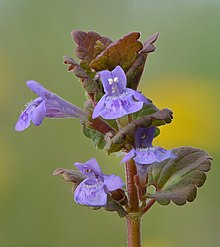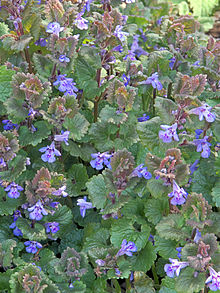Glechoma hederacea
| Glechoma hederacea | |
|---|---|

| |
| Scientific classification | |
| Kingdom: | Plantae |
| Clade: | Tracheophytes |
| Clade: | Angiosperms |
| Clade: | Eudicots |
| Clade: | Asterids |
| Order: | Lamiales |
| Family: | Lamiaceae |
| Genus: | Glechoma |
| Species: | G. hederacea
|
| Binomial name | |
| Glechoma hederacea | |
| Synonyms[1] | |
|
List
| |


Glechoma hederacea is an aromatic, perennial, evergreen creeper of the mint family Lamiaceae. It is commonly known as ground-ivy, gill-over-the-ground,[2] creeping charlie, alehoof, tunhoof, catsfoot, field balm, and run-away-robin.[2] It is also sometimes known as creeping jenny, but that name more commonly refers to Lysimachia nummularia. It is used as a salad green in many countries. European settlers carried it around the world, and it has become a well-established introduced and naturalized plant in a wide variety of localities. It is also considered an aggressive invasive weed of woodlands and lawns in some parts of North America. In the absence of any biological control, research conducted by the USDA[3] herbicides are relied upon (despite their drawbacks) particularly for woodland ecosystems. The plant's extensive root system makes it difficult to eradicate by hand-pulling.
Description
[edit]Glechoma hederacea can be identified by its round to reniform (kidney- or fan-shaped), crenate (with round-toothed edges) opposed leaves 2–3 cm (0.79–1.18 in) diameter, on 3–6 cm (1.2–2.4 in) long petioles attached to square stems that root at the nodes. The plant spreads either by stolon or seed, making it exceptionally difficult to eradicate. It is a variable species, its size being influenced by environmental conditions, from 5–50 cm (2.0–19.7 in) tall.[4]
G. hederacea is sometimes confused with common mallow (Malva neglecta), which also has round, lobed leaves, but mallow leaves are attached to the stem at the back of a rounded leaf, where ground ivy has square stems and leaves, which are attached in the center of the leaf, more prominent rounded lobes on their edges, attach to the stems in an opposite arrangement, and have a hairy upper surface. In addition, mallow and other creeping plants sometimes confused with ground ivy do not spread from nodes on stems. In addition, ground ivy emits a distinctive odor when damaged, being a member of the mint family.
The flowers of G. hederacea are bilaterally symmetrical, funnel shaped, blue or bluish-violet to lavender, and grow in opposed clusters of two or three flowers in the leaf axils on the upper part of the stem or near the tip. It usually flowers in the spring.
G. hederacea thrives in moist shaded areas, but also tolerates sun very well. It is a common plant in grasslands and wooded areas or wasteland. It also thrives in lawns and around buildings, since it survives mowing. Part of the reason for its wide distribution is its rhizomatous method of reproduction. It forms dense mats that can take over areas of lawn and woodlands, thus is considered an invasive or aggressive weed in suitable climates where it is not native.[2]
Ecological aspects
[edit]A number of wild bees collect pollen from this plant, including Anthophora furcata, Anthidum manicatum, Anthophora plumipes, Anthophora quadrimaculata, Osmia aurulenta, Osmia caerulentes, and Osmia uncinata. The plant is also galled by several insects,[5] including Rondaniola bursaria (lighthouse gall),[6] Liposthenes glechomae[7] or Liposthenes latreillei (Kieffer, 1898) (a gall wasp).[8]
Reproduction
[edit]Glechoma hederecea is gynodioecious, with genets being either female or hermaphrodite. The females depend upon pollen from hermaphrodites for pollination.[4] Female flowers tend to be smaller than hermaphrodite flowers.[4] Disagreement exists among biologists as to whether hermaphrodite flowers can pollinate themselves.[4] The plant spends the winter as either a small ramet or a small rosette. It produces flowers between April and July, which are visited by many types of insects, and can be characterized by a generalized pollination syndrome.[9] Each pollinated flower can produce up to four seeds, which are dispersed by the stem bending over and depositing the ripe seeds in the ground adjacent to the parent plant, although ants may carry the seeds further. The seeds germinate a few days after contact with moisture, although they can be stored dry.[4] Dry storage for a period up to a month is thought to improve the germination rate.[4]
The plant can also reproduce clonally, with the stems bending down to the earth and allowing roots to attach themselves.[4] Single clones can grow several metres across, although precise data are not available.[4]
Cultivation and medicinal and culinary uses
[edit]
Some people consider G. hederacea to be an attractive garden plant, and it is grown in pots and occasionally as a groundcover. Easily cultivated, it grows well in shaded places. A variegated variety is commercially available; in many areas, this is the dominant form, which has escaped cultivation and become established as an aggressive, adventitious groundcover.
This species is considered a non-native plant in the United States, and invasive in some States.[10] It has invaded wild areas, sometimes choking out native wildflowers.
G. hederacea was also widely used by the Saxons in brewing ale as flavoring, clarification, and preservative, and later by the English, before the introduction of hops into brewing in the late 15th century. From this, the brewing-related names arose for the herb - alehoof, tunhoof, and gill-over-the-ground. In the 18th century, beer brewed with ground ivy was known as gill ale and was said to have medicinal properties.[11]
Enzymes similar to chymosin in G. hederacea have been used in the cheese-making process as a substitute for animal rennet.[12][13]

Traditional medicine
[edit]G. hederacea has been used in the traditional medicine of Europe going back thousands of years; Galen recommends the plant to treat inflammation of the eyes. John Gerard, an English herbalist, recommended it to treat tinnitus, and as a "diuretic, astringent, tonic, and gentle stimulant. Useful in kidney diseases and for indigestion." It has also been used as a "lung herb". Its presence as an invasive weed in North America is the result of the value placed on it by European settlers as a medicinal herb and ale preservative; the species was imported and widely cultivated in herb and kitchen gardens.[14] Its other traditional uses include as an expectorant or astringent, and to treat bronchitis.[15] In traditional Austrian medicine, the herb has been prescribed for internal application as salad or tea for the treatment of a variety of different conditions, including disorders associated with the liver and bile, gastrointestinal tract, respiratory tract, kidneys and urinary tract, fever, and influenza.[16]
Safety
[edit]Although it has been used by humans as a salad green and in herbal medicines for thousands of years, the species is also believed to be toxic to livestock, particularly horses. Wild pigs, however, are reported to feed on it. Some accounts report it is toxic to rodents, while bank voles in Great Britain have been observed to use it as a food source.[3] Like other members of the Lamiaceae, G. hederacea contains bioactive volatile oils, including terpenoids and pulegone; these are responsible for the characteristic "minty" odor and taste of plants in the mint family. Their activity in humans varies depending on many factors, including concentration, quantity of intake, and whether administration is internal or external. Lamiacaeae plants with very high volatile oil concentrations, such as European pennyroyal (Mentha pulegium), have traditional uses as disinfectants, flea-killers, and abortifacients, and are hepatotoxic to humans.[17] Other members of the Lamiacaeae, such as Mentha spicata, spearmint, are widely and safely used in teas and flavorings for their volatile oils. The concentration of volatile oil in G. hederacea is less than 1/30th that in European pennyroyal.[15] The effects of Glechoma on humans have been little studied.
Control
[edit]A non-native invasive in North America, Glechoma is familiar to a large number of people as a weed, a property it shares with many others of the mint family. It can be a problem in heavy, rich soils with good fertility, high moisture, and low boron content. It thrives particularly well in shady areas where grass does not grow well, such as woodlands, although it can also be a problem in full sun.
Because the plant is stoloniferous and continues to spread from its roots or bits of stem which reroot, even small infestations resist repeated hand weeding. Like crabgrass, G. hederacea's root has a tough-to-remove ball (unbelied by its delicate wide leaves).
No biological control agents are known to help to reduce its spread in North America.[3] Commercial herbicides containing triclopyr are used to control G. hederacea.
G. hederacea is also unusually sensitive to boron, and can be killed by applying borax (sodium tetraborate) in solution. However, borax is toxic to ants and to animals at only slightly higher concentrations, and does not break down in the environment. In addition to adverse long-term effects on soil or groundwater,[18][19] recent research discounts the very efficacy of borax treatment, primarily because finding the correct concentration for a given area is difficult and the potential for damaging desired plants is high.[20]
References
[edit]- ^ "Glechoma hederacea L." Plants of the World Online. Royal Botanic Gardens, Kew. Retrieved 20 November 2024.
- ^ a b c Connecticut Invasive Plant List, Connecticut Agricultural Experiment Station, January, 2004
- ^ a b c Waggy, Melissa (2009). "Glechoma hederacea". USDA FEIS. United States government. Retrieved 19 March 2018.
- ^ a b c d e f g h Hutchings, Michael J.; Price, Elizabeth C. (1999). "Glechoma hederecea". Journal of Ecology. 87 (205): 347–364. doi:10.1046/j.1365-2745.1999.00358.x. S2CID 85065999.
- ^ ""A Nature Observer′s Scrapbook" galls found on herbaceous, soft stemmed plants". Archived from the original on 2020-02-16. Retrieved 2010-06-06.
- ^ [1] Archived July 8, 2008, at the Wayback Machine
- ^ Leafminers of Europe - Liposthenes glechomae Archived 2007-09-08 at the Wayback Machine
- ^ [2] Archived July 20, 2008, at the Wayback Machine
- ^ Van Der Kooi, C. J.; Pen, I.; Staal, M.; Stavenga, D. G.; Elzenga, J. T. M. (2015). "Competition for pollinators and intra-communal spectral dissimilarity of flowers". Plant Biology. 18 (1): 56–62. doi:10.1111/plb.12328. PMID 25754608.
- ^ U.S. Department of Agriculture Natural Resources Conservation Services
- ^ Blackwell, Elizabeth (1737). A Curious Herbal. London: Samuel Harding. p. 57.
- ^ Cheesemakingrecipe.com: Rennet for Cheese Making
- ^ TheCheesewanker.com: Science, Plant based rennet
- ^ Stubbendieck, James; Coffin, Mitchell J.; Landholt, L. M. 2003. Weeds of the Great Plains. 3rd ed. Lincoln, NE: Nebraska Department of Agriculture, Bureau of Plant Industry. 605 p. In cooperation with: University of Nebraska, Lincoln.
- ^ a b Joanne Barnes, Linda A. Anderson, J. David Phillipson, Herbal Medicines, 2nd ed., Pharmaceutical Press, London, 2002.
- ^ Vogl, S; Picker, P; Mihaly-Bison, J; Fakhrudin, N; Atanasov, AG; Heiss, EH; Wawrosch, C; Reznicek, G; Dirsch, VM; Saukel, J; Kopp, B (2013). "Ethnopharmacological in vitro studies on Austria's folk medicine - An unexplored lore in vitro anti-inflammatory activities of 71 Austrian traditional herbal drugs". J Ethnopharmacol. 149 (3): 750–71. doi:10.1016/j.jep.2013.06.007. PMC 3791396. PMID 23770053.
- ^ "Pennyroyal Uses, Benefits & Side Effects - Drugs.com Herbal Database". Drugs.com. Retrieved 2020-04-25.
- ^ Creeping Charlie Control - Borax Archived 2006-08-22 at the Wayback Machine University of Minnesota Info-U
- ^ Borax on Ground Ivy: Boon or Bane? Horticulture and Home Pest News, Iowa State University
- ^ "Controlling Creeping Charlie". Archived from the original on 2008-06-08. Retrieved 2008-06-01. University of Wisconsin
Further reading
[edit]- An, HJ; Jeong, HJ; Um, JY; Kim, HM; Hong, SH (2006). "Glechoma hederacea inhibits inflammatory mediator release in IFN-gamma and LPS-stimulated mouse peritoneal macrophages". Journal of Ethnopharmacology. 106 (3): 418–24. doi:10.1016/j.jep.2006.01.024. PMID 16530364.
